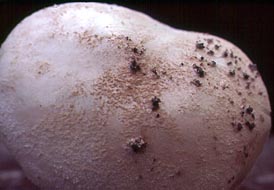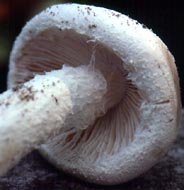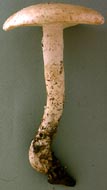[ Section Lepidella page. ]
[ Amanita Studies home. ]
[ Keys & Checklist/Picturebooks ]
[ Great Smoky Mtns. N.P. & region list ]
[ New Jersey & region list ]
[ E. Texas & Gulf Coast list ]
"Chlorine Lepidella"



Technical description (t.b.d.)
The cap is 70 - 102 mm wide, white to off-white, sometimes with very pale gray tint here and there, convex to broadly convex, then subplanar, shiny when dry; context white, unchanging when cut or bruised, soft, 5 - 9 mm thick over stipe, thinning evenly to margin; margin nonstriate, appendiculate with white flocculose to submembranous material, slightly incurved at first, then decurved; universal veil as crusty patches, granular patches, or flocculose to pulverulent warts (small or granular to subpyramidal, latter especially over disc), often as flocculence or fine scales near margin, white, sometimes becoming gray or brownish with age and exposure, easily removed.
The gills are nearly free to adnexed to subadnate, sometimes leaving impression in flocculence of upper stipe, close, pale cream in mass, white to whitish in side view, unchanging when cut or bruised, but sometimes faintly sordid on old drying wounds, 5 - 9.5 mm broad, occasionally forking near margin, with edges white and minutely flocculose and darkening on drying; the short gills are rounded truncate to subattenuate to attenuate, of diverse lengths, plentiful, often several between pair of otherwise adjacent gills.
The stipe is 115± × 12 - 15 mm, white, unchanging even where handled, equal in upper two-thirds, narrowing upward in bottom third, densely cottony flocculose to floccose-scaly (especially in upper several cm) or as irregular felted patches amid dense flocculence, with flocculent material easily coming off when handled; bulb not pronounced to clavate, 30± × 25 - 30 mm, sometimes twisted, sometimes slightly flattened, often below level of substrate, sometimes radicating; context solid, but easily breaking, white, unchanging when cut or bruised; annulus not membranous, subapical?, white, weakly submembranous-fibrillose, often falling away completely or leaving narrow subapical? annular zone; volva occasionally present as flat warts at base of stipe and above or on upper part of bulb.
Odor faintly to moderately of chlorine or of “old ham,” meaty-nauseous when drying. Taste not recorded.
The spores measure (7.5-) 8.0 - 11.0 (-12.2) x (4.2-) 4.7 - 6.5 (-7.7) µm and are ellipsoid to elongate to cylindric and amyloid. Clamps are prominent and common on the bases of basidia.
Amanita chlorinosma occurs from Massachusetts and Illinois south to Florida. It occurs with pine (Pinus) or oak (Quercus) or in mixed forest with pine or oak and the following other possible associates: Birch (Betula) and aspen (Populus spp.). The present species, or something very similar to it, is reported from central Mexico.
Bas created his stirps Chlorinosma to include the present species as well as A. lanosa Beeli, A. lanosula Bas, and A. tephrea Bas nom. prov. Since 1969, A. elongatispora A. E. Wood has been suggested as an additional member of the stirps. -- R. E. Tulloss
Photos: R. E. Tulloss (center, North Carolina; left & right, Illinois)
[ Section Lepidella page. ]
[ Amanita Studies home. ]
[ Keys & Checklist/Picturebooks ]
[ Great Smoky Mtns. N.P. & region list ]
[ New Jersey & region list ]
[ E. Texas & Gulf Coast list ]
Last change 28 February 2009.
This page is maintained by R. E. Tulloss.
Copyright 2002, 2003, 2004, 2009 by Rodham E. Tulloss.
Photographs copyright 2002 by Rodham E. Tulloss.